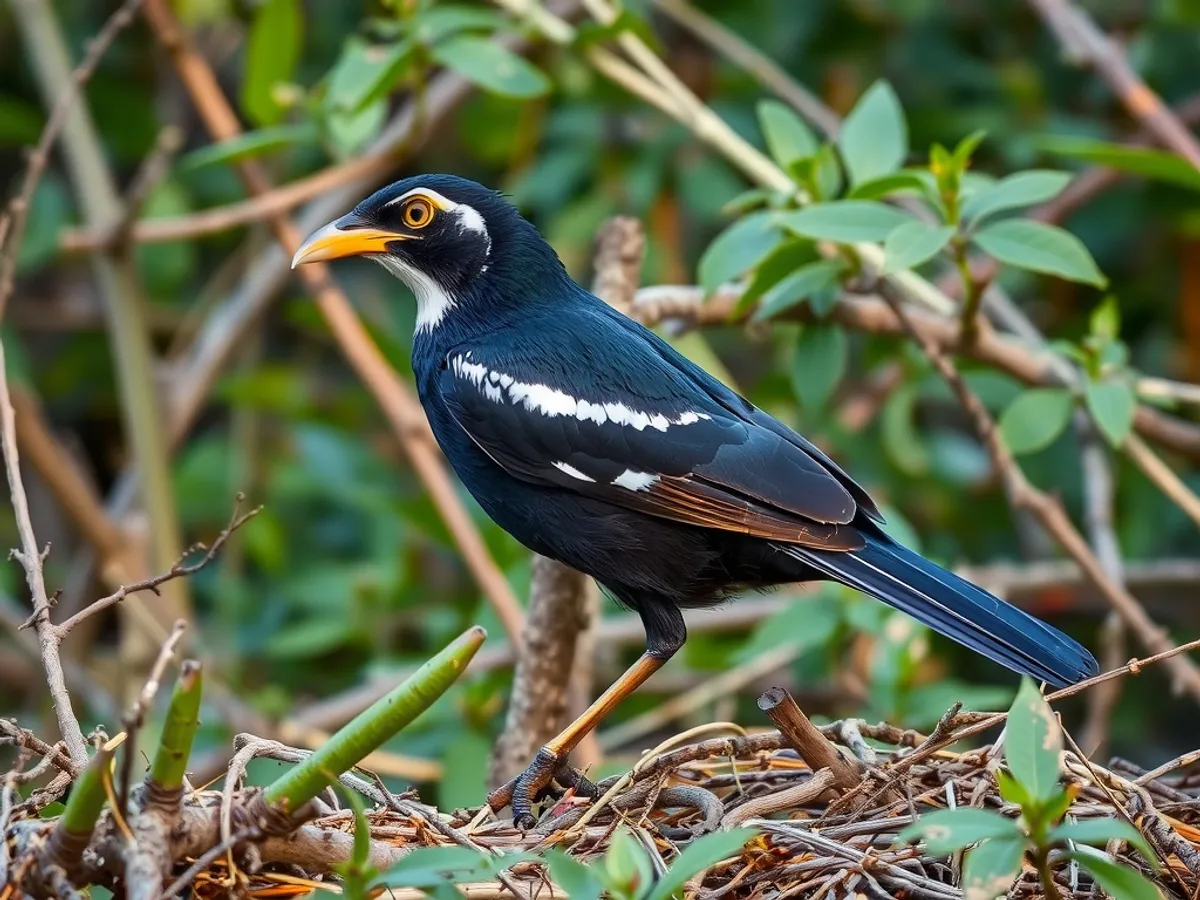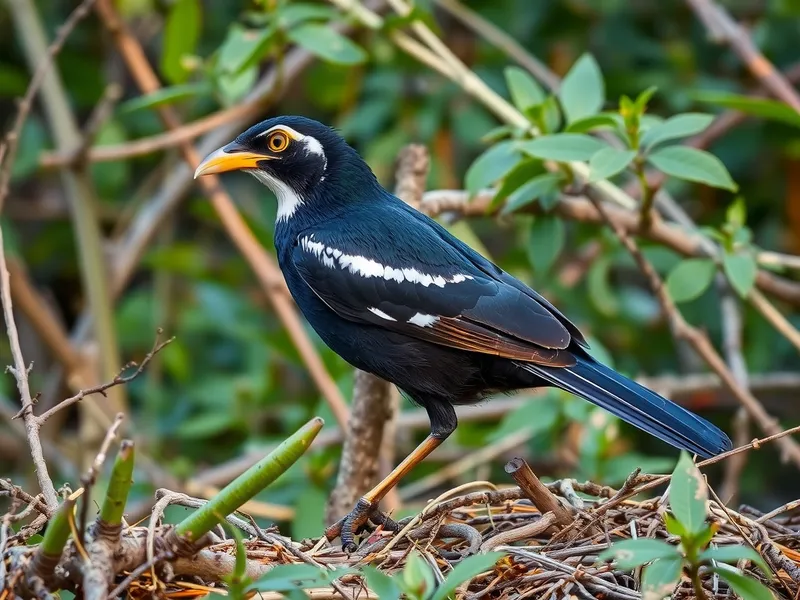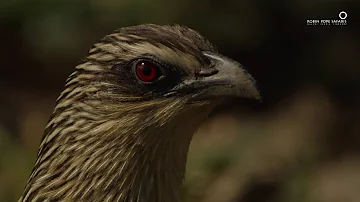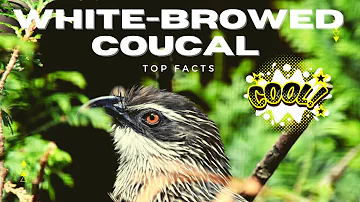
White-browed Coucal
Centropus superciliosus

Meet the White-browed Coucal
The White-browed Coucal is a medium-sized bird native to sub-Saharan Africa, recognized by its distinctive white eyebrow stripe above a dark eye and rufous wings. Its body is mostly brown with a creamy-white underbelly, and it has a long, broad tail. These birds are often found skulking in dense vegetation, such as thickets and savannas, where they hunt insects, small vertebrates, and occasionally berries. White-browed Coucals are known for their rich, bubbling calls, especially during the breeding season. They are secretive and prefer to move quietly through the undergrowth, making them more often heard than seen.
Classification
Bird
Habitat
Dense bush, thickets, savanna, and wetlands
Diet
Omnivore
Lifespan
7-10 years
Conservation
Least Concern
Weight
100-170 g
📖Fascinating Facts
Distinctive Calls
The White-browed Coucal is famous for its bubbling, descending call that is commonly heard at dawn and dusk.
Secretive Nature
They prefer dense vegetation and are often difficult to spot, moving quietly through the undergrowth.
Dedicated Parents
Unlike many other cuckoos, White-browed Coucals incubate their own eggs and care for their young.
📋Detailed Description
The White-browed Coucal (Centropus superciliosus) is a robust, medium-sized cuckoo, typically measuring 36–42 cm in length and weighing between 110–210 grams. It is distinguished by a prominent white supercilium (eyebrow) contrasting with a dark brown to blackish crown and face. The upperparts are rich chestnut-rufous, especially on the wings, while the back and tail are darker brown with a greenish gloss. The underparts are creamy-white to buff, providing camouflage in dense vegetation. The tail is long and broad, with graduated feathers tipped in white, aiding in balance and maneuverability through thick undergrowth. The bill is strong, slightly decurved, and black, adapted for capturing a variety of prey. Eyes are deep red in adults, while juveniles have brown eyes and more mottled plumage. The legs and feet are strong and adapted for walking and hopping through tangled vegetation. This species is generally solitary or found in pairs, and is more often heard than seen due to its secretive habits. Its vocalizations are a series of bubbling, descending notes, often given at dawn and dusk.
💡 Did you know?
Despite being a cuckoo, the White-browed Coucal does not practice brood parasitism and raises its own chicks.
🔬Research & Sources
Wikipedia Summary
The white-browed coucal or lark-heeled cuckoo, is a species of cuckoo in the family Cuculidae. It is found in sub-Saharan Africa. It inhabits areas with thick cover afforded by rank undergrowth and scrub, including in suitable coastal regions. Burchell's coucal is sometimes considered a subspecies.
Last Modified: 12/21/2023
🎭Behavior & Social Structure
White-browed Coucals are primarily terrestrial and exhibit skulking behavior, preferring to move quietly through dense thickets and tall grasses. They are diurnal, with peak activity in the early morning and late afternoon. Their diet is omnivorous, consisting mainly of large insects (grasshoppers, beetles, caterpillars), spiders, snails, small reptiles, amphibians, and occasionally small birds and mammals. They also consume fruits and berries, especially during the dry season when animal prey is scarce. Coucals hunt by stalking and pouncing on prey, using their strong bill to subdue and kill. Socially, they are monogamous and territorial, with pairs maintaining and defending territories through vocalizations and displays. They are not brood parasites like many other cuckoos; instead, they build their own nests and rear their young. Roosting occurs in dense cover, and they rarely fly long distances, preferring to run or hop through vegetation.
👶Reproduction & Life Cycle
Breeding occurs during the rainy season, which varies regionally but often coincides with increased food availability. Pairs construct a large, domed nest of grasses and leaves, usually low in a bush or thicket (0.5–3 m above ground). The female typically lays 2–4 white eggs, which are incubated by both parents for about 14–15 days. Both sexes participate in feeding and brooding the chicks, which are altricial at hatching and fledge after approximately 17–21 days. Parental care continues for several weeks post-fledging. Unlike many cuckoos, White-browed Coucals do not practice brood parasitism; instead, they exhibit strong parental investment and cooperative care.
🛡️Adaptations & Survival
The species' cryptic coloration and preference for dense, tangled vegetation provide effective camouflage from predators. Their long, graduated tail aids in balance and agility when moving through undergrowth. The robust, decurved bill is well-suited for capturing a wide range of prey, including hard-shelled insects and small vertebrates. Behavioral adaptations include secretive movement and the use of alarm calls to warn mates or offspring of danger. Their omnivorous diet allows them to exploit a variety of food sources, enhancing survival in fluctuating environments. The ability to breed opportunistically in response to rainfall is an adaptation to the unpredictable climate of sub-Saharan Africa.
📚Research Sources
🎨Cultural Significance
In several African cultures, coucals are associated with folklore and are sometimes regarded as omens or weather predictors, due to their distinctive calls before rain. In some regions, their calls are believed to herald changes in weather or the onset of the rainy season. There are few records of direct use in traditional medicine or as food, likely due to their secretive habits and unremarkable plumage compared to more conspicuous birds.
🔬Recent Research & Discoveries
Recent studies have focused on the phylogenetic relationships within the Centropus genus, with some debate regarding the taxonomic status of Burchell's Coucal (Centropus burchellii), which is sometimes treated as a subspecies of C. superciliosus. Bioacoustic research has analyzed the structure and function of their vocalizations, revealing complex duetting behavior in pairs. Ecological studies have examined their role in controlling insect populations and their adaptability to human-altered landscapes. Ongoing research includes the effects of habitat fragmentation and climate change on breeding success and distribution.
🎥Wildlife Videos

Safari Diaries: Killer Bird
Safari Diaries: Killer Bird Whether you're a frog or a grasshopper – be very afraid! A predator is on the prowl. The white-browed ...
Robin Pope Safaris

Coucal vs Chameleon
Watch as this White-browed Coucal thinks he can catch an easy meal in the form of a Flap-necked Chameleon.
Shenton Safaris

White-browed coucal || Lark-heeled cuckoo || Cuckoo Chapter - 30 || The Rup animal....
The white-browed coucal or lark-heeled cuckoo , is a species of cuckoo in the family Cuculidae. It is found in sub-Saharan Africa.
The Rup animal

White-browed Coucal facts 🦜 Lark-heeled Cuckoo 🦜 found in sub-Saharan Africa
birddocumentary white-browed coucal documentary facts Picture ...
Amazing Planet!

Burchell's Coucal facts 🦜 species of cuckoo found in sub-Saharan Africa
amazinganimals facts for kids Picture https://commons.wikimedia.org/wiki/File:Burchell%27s_Coucal ...
Amazing Planet!

White browed Coucal (Centropus superciliosus)
Enjoy the amazing call of the White-browed Coucal. Nature Tanzania welcomes you to join the conservation course to support its ...
Nature Tanzania
🌍Habitat Information
The White-browed Coucal typically inhabits Dense bush, thickets, savanna, and wetlands environments. White-browed Coucals have adapted to their environments with specialized features and behaviors.
Primary Habitat:
Dense bush, thickets, savanna, and wetlands
More detailed habitat information will be available soon.
🛡️Conservation Status
The White-browed Coucal is currently classified as Least Concern. Conservation efforts are crucial for preserving this species for future generations.
Common Threats:
- 🏠Habitat loss and fragmentation
- 🌡️Climate change impacts
- 🎯Hunting and poaching
- 🏭Human-wildlife conflict
⚠️Threats & Conservation Challenges
Currently assessed as Least Concern by the IUCN, the White-browed Coucal has a wide distribution and a stable population. However, localized threats include habitat loss due to agricultural expansion, overgrazing, and urbanization, which can reduce the availability of suitable dense cover. Pesticide use may indirectly affect populations by reducing insect prey abundance. The species is generally tolerant of moderate habitat disturbance and can persist in secondary growth and degraded areas, but severe habitat fragmentation could pose future risks. There is no evidence of significant hunting or trapping pressure.
🔬Scientific Classification
Scientific Name
Centropus superciliosus
Classification Hierarchy
🔍 About Taxonomic Classification
Taxonomic classification is a hierarchical system used by scientists to classify and organize living organisms based on shared characteristics and evolutionary relationships.
The system moves from broad categories (Kingdom) to increasingly specific ones, with each animal's scientific name typically consisting of its Genus and species.
📝Community Notes
Share your observations and insights about the White-browed Coucal with our community of wildlife enthusiasts.
Join Our Community
Sign in to share your observations and connect with fellow wildlife enthusiasts.
Sign In to ContributeNo community notes yet
Be the first to share your observations about the White-browed Coucal!
Explore White-browed Coucal
Select a tab above to learn more about this amazing animal.
📸Photo Gallery
No photos available for this animal yet.
🌟Discover More Wildlife
Continue your journey of discovery with more fascinating animals from our database
